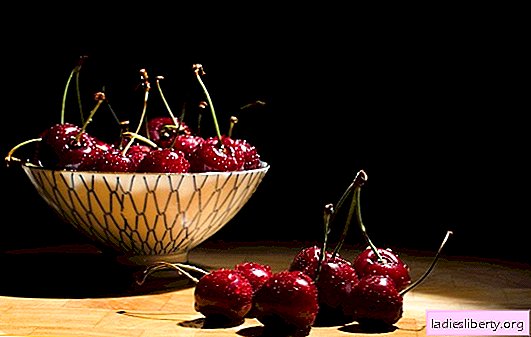
Almost every one of us since childhood loves to feast on cherries.
But we think about its benefits and possible harm at an older age.
But is cherry really so useful and can everyone eat it?
Cherry: benefit and harm. Vitamin and mineral composition of fruits
Until now, scientists have not come to a consensus: is cherry a berry or a fruit? Some attribute it to berries, the second claim that it is a stone fruit. However, disagreement does not make the taste of cherries worse and the composition less valuable.
Cherry is rich in vitamins B, C, PP and B12 (folic acid). It also contains minerals such as potassium, calcium, phosphorus, magnesium, sodium, manganese and iron. Thanks to organic acids, plant fiber, fructose and glucose in the fruits of cherries, it is used to treat many diseases.
Cherry is rich in a substance such as inositol. It contributes to the normalization of metabolism.
The anthocyanins included in the composition favorably affect the capillaries, namely, strengthen their walls.
Coumarins and oxycoumarins in cherries make its fruits indispensable for people with coronary heart disease, thrombophlebitis and phlebothrombosis.
Chlorogenic acid normalizes the functioning of the kidneys and liver.
Pectin and fiber remove toxins and have a beneficial effect on intestinal function.
Iron and copper increase hemoglobin levels.
What is useful cherry
Cherry has long been known as a product of eternal youth. Due to the high content of antioxidants in it, its use inhibits the aging of the body. It has a strengthening effect on all vital systems of the body: heart, nervous system, intestines, liver and kidneys. Also, cherry fruits improve vision and lower blood cholesterol.
What useful properties does this product still have?
1. Increases hemoglobin and lowers blood pressure, strengthens capillaries.
2. Prevents the development of heart attack, stroke, thrombosis, complications of atherosclerosis and reduces the risk of an attack of angina pectoris.
3. Relieves inflammation of the joints, reduces the level of uric acid in the body, which contributes to the best treatment of gout and arthritis.
4. Due to the high copper content in the composition, cherries are able to treat mental abnormalities (of course, coupled with drug treatment), including epilepsy.
5. Cherry can be used to accelerate the treatment of dysentery, as well as getting rid of staphylococci and streptococci.
6. The high content of pectins has a positive effect on the intestines: toxins and toxins are removed, constipation is prevented.
7. Cherry is also used to treat cough (as an expectorant) and reduce body temperature.
8. In women, the fruits of cherries make menopause easier.
It is worth noting that this delicacy is used not only for its intended purpose, but also for cosmetic purposes. So, the pulp and cherry juice are part of many masks and creams aimed at strengthening the skin and hair.
Many women use cherries as the main ingredients in a diet for weight loss. Calorie content of fruits is only 52 kcal per 100 g of product.
Cherry is one of the few products that is allowed for people with diabetes, as it has a low glycemic index. The anthocyanins in the pulp slow down the absorption of sucrose, which is also very important for diabetics.
For pregnant women, cherries are very useful as a prophylaxis of anemia, which often appears when carrying a baby. The fruit also contains folic acid, which is very important for the proper formation and further development of the baby in the womb.
You can get valuable substances from cherry fruits not only during their ripening. The berry perfectly tolerates freezing and retains almost all of its beneficial properties.
Cherry Leaves
Invaluable benefits for the body can bring not only the fruits, but also the leaves of the cherry tree. They are brewed to stop bleeding and alleviate the condition with hypertension.
No less popular and infusions of leaves. They are drunk with frequent nosebleeds and heavy menstruation. And people suffering from liver diseases are recommended from time to time to drink a decoction of cherry leaves in milk.
Cherry: the benefits and harms of excessive consumption
Despite a wide range of beneficial properties, cherries can be harmful. First of all, this applies to cherry seeds. They contain substances such as glycoside and amygdalin. When they enter the intestines, they interact with putrefactive bacteria, decompose and form a toxic substance - hydrocyanic acid. It is dangerous for humans because it causes severe poisoning.
To reduce the risk of possible harm from eating cherries, it is imperative to spit out the bones.
Also, do not forget that before eating cherries, it must be thoroughly washed. Even if the fruits were picked from a tree, this does not mean that they are perfectly clean. At a minimum, roadside dust settles on them. In the best case, this can lead to an upset bowel; in the worst, it can lead to serious poisoning.
Excessive consumption of cherries negatively reflects on tooth enamel. It is advisable, after you have eaten the fruit, to brush your teeth well or rinse your mouth.
Cherry: useful properties and contraindications
Not everyone can eat cherries. Even if you spit out the seeds and wash the fruits well, the body can be harmed by eating berries. This applies to those who have the following diseases:
● stomach ulcer;
● increased acidity of the stomach;
● obesity;
● chronic pulmonary disease;
● disrupted digestive tract;
● gastritis in an acute stage.
The benefits and harms of cherries: in what form can you eat
The most valuable in usefulness are considered fresh fruits. However, cherries can be prepared for the winter. There are several ways to do this.
What is cherry useful for and how to freeze
You can freeze fruits with seeds or without them. The difference will be that in the first case the cherry will be more saturated. How to freeze cherries:
1. Fruits should be picked only whole, without damage, not overripe. It should also be remembered that the less time passes from picking cherries to freezing, the better.
2. Do not wash cherries before freezing.
3. You can store in bags or plastic containers with a lid. In the first case, it is better to freeze cherries on a baking sheet first, so that the fruits are whole one to one. When choosing containers for freezing, it is important to remember that cherries absorb foreign odors well, so you should take care of its tightness.
4. The optimum freezing temperature for cherries is in the range from -18 to -23 degrees.
5. The berry can be stored for up to one year.
Frozen fruits retain almost all the properties that are fresh. They can be used in baking, for boiling compote or adding to cereal.
What is useful cherry and how to dry it
The fruits are dried without stalks and seeds. In a sealed container and at room temperature, cherries in this form can be stored for several months. How to dry the fruits:
1. The oven must be heated to 90 degrees.
2. Wash the cherry well, remove the seeds and stalks, dry it on a paper towel.
3. The baking sheet is lined with baking paper, on which cherries are laid out in one even layer.
4. Drying lasts for 8 hours with the oven door open.
Dried fruits become the size of raisins and have a pleasant purple tint. Dried cherries can be enjoyed as a snack or added to various dishes and compotes. The only negative of such a blank is that the fruits lose about half of their nutrients.
Dried cherry: calories and how to harvest
Calorie content in this form is only 290 kcal per 100 g of product. Due to this, it can be used as a snack or treat during the diet.
Dried cherries differ from dried cherries in that it is more fragrant and tender. Unlike dried, dried is harvested without exposure to high temperatures.
How to cook:
1. Cured cherries are prepared in syrup. Based on 3 kg of fresh fruit, 1 liter of water and 800 g of sugar are taken.
2. Ripe, intact cherries are well washed, cleaned of seeds and stalks.
3. Water is poured into the pan and sugar is poured. When the syrup boils and the sugar is completely dissolved, cherry is added to it.
4. After 8 minutes of cooking, the cherry is removed from the pan in a colander so that the glass is excess liquid.
5. The cooled and dried fruits are laid out on a baking sheet lined with baking paper, and cleaned in a dry, dark place for 3 days.
6. After this time, each cherry is turned over and removed back for another one and a half weeks.
Ready dried cherries are stored in closed containers for several months. It can be eaten either as an independent dish, or added to pastries, cereals, drinks and desserts. This process of harvesting fruits allows you to save most of the beneficial properties.
Cherry is a delicious and very healthy product. The main thing to remember is that before eating, even fruits torn from a tree must be washed. Do not forget about the measure, because the uncontrolled use of cherries can not only not bring benefits, but also harm the body.











